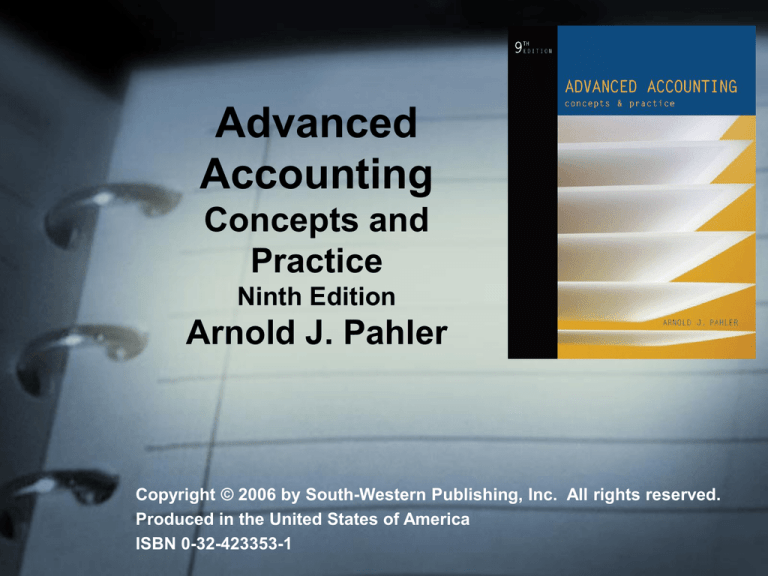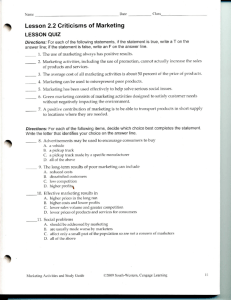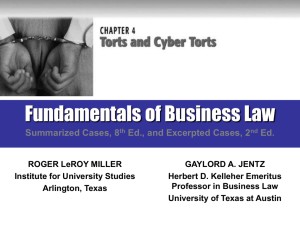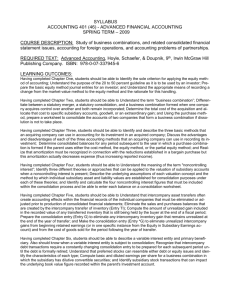
Advanced
Accounting
Concepts and
Practice
Ninth Edition
Arnold J. Pahler
Copyright © 2006 by South-Western Publishing, Inc. All rights reserved.
Produced in the United States of America
ISBN 0-32-423353-1
CHAPTER 1
WHOLLY OWNED
SUBSIDIARIES—
AT DATE OF CREATION
FOCUS OF CHAPTER 1
• Internal Expansion—Choosing Between
Subsidiary vs. Branch Form of
Organization
• Created Subsidiaries—As Opposed to
Acquired Subsidiaries
(addressed in Chapters 4-6)
• Consolidation—The Required Manner of
Reporting for a Parent and a Subsidiary—
with few exceptions.
Copyright © 2006 by South-Western. All rights reserved.
Subsidiary Versus Branch:
Each Has Its Advantages
• Legal considerations—limited [subsidiary]
versus unlimited [branch] liability.
• Tax considerations—Pay IRS when
earnings occur [branch] vs. when
dividends are paid [subsidiary].
• Patent protection—Keep it [branch] or lose
it.
• Marketplace identity—To create it, use the
subsidiary form of organization.
• Practicality—Branch is simple.
Copyright © 2006 by South-Western. All rights reserved.
Consolidation: The
Concept
• A “pro forma” presentation—it means “as
if” the parent and subsidiary were a
SINGLE legal entity with one or more
branches.
• It is a LEGAL FICTIONAL
PRESENTATION (an accounting mirage).
Copyright © 2006 by South-Western. All rights reserved.
Consolidation: The Concept
• Remember—the parent has the POWER
to liquidate the subsidiary into a branch
(thus shattering the subsidiary’s “protective
shell”).
2-1=1
The result: A SINGLE legal entity.
Copyright © 2006 by South-Western. All rights reserved.
Consolidation: The 3
Considerations
• In buying real estate, the three most
important considerations are “location,
location, and location.”
• In determining whether consolidation is
appropriate, the three most important
considerations are “control, control, and
control.”
Copyright © 2006 by South-Western. All rights reserved.
Control:
It Means Having Power
• To hire and fire management.
• To set management’s compensation.
• To decide when to pay dividends.
Copyright © 2006 by South-Western. All rights reserved.
Control (cont.):
It Means Having Power
• To approve operating, capital,
and R&D budgets.
• To direct the use of the subsidiary’s
assets.
• To liquidate the subsidiary into a
division if desired.
Copyright © 2006 by South-Western. All rights reserved.
Control: By What Means?
• The Usual Way—Owning more than 50%
of the subsidiary’s outstanding voting stock
(50% plus only 1 share will do it).
• The Unusual Way—Having contractual
agreements or financial arrangements
that effectively achieves control.
Copyright © 2006 by South-Western. All rights reserved.
Control: Ways It Can Be Lost
Or Lessened
• Bankruptcy filing—the judge takes
control.
• Foreign government intervention in dayto-day operations.
• Currency transfer restrictions imposed
by a foreign government.
• Dividend restrictions imposed by U.S.
government regulatory authorities (banking
and S&L industries).
Copyright © 2006 by South-Western. All rights reserved.
Loss of Control: To What
Extent?
• SUBSTANTIAL or COMPLETE
LOSS OF CONTROL—stop
consolidating:
– Bankruptcy.
– Foreign government intervention.
– Severe long-term currency transfer or
dividend restrictions.
• SIGNIFICANT LOSS OF CONTROL—
use judgment as to consolidating.
Copyright © 2006 by South-Western. All rights reserved.
When to Consolidate:
What’s
Not Relevant
• Whether the subsidiary:
–
–
–
–
–
–
Is a foreign subsidiary.
Is in a different line of business.
Is making or losing money.
Pays dividends.
Is a start-up company.
Operates under a “hands-off”
decentralized operating policy.
Copyright © 2006 by South-Western. All rights reserved.
Consolidation: Aggregated
versus Disaggregated Format
• AGGREGATED Presentation:
Sum the parent’s and subsidiary’s
accounts.
– Makes sense if in the same lines of
business.
–
Copyright © 2006 by South-Western. All rights reserved.
Consolidation: Aggregated
Versus Disaggregated Format
• DISAGGREGATED Presentation:
Present subsidiary’s accounts
separately (“layered,” “tiered,”
“stacked,” or “pancake” format).
– Makes sense if in different lines of
business.
–
Copyright © 2006 by South-Western. All rights reserved.
Types of Entries:
How Do They Differ?
•
•
•
•
Adjusting journal entries (AJEs).
Reclassifying journal entries (RJEs).
Reversing entries.
Proposed journal entries (by auditors)
(PJEs).
• Consolidation entries.
–
Posted only to worksheets.
–
Produce a substitution result.
Copyright © 2006 by South-Western. All rights reserved.
Review Question #1
• Under GAAP, a valid reason for NOT
CONSOLIDATING is that the subsidiary:
A. Is located in a developing country.
B. Has no intercompany transactions.
C. Buys 100% of its inventory from its
parent.
D. Is in a weak financial condition.
E. Is larger than its parent.
F. Is reporting substantial losses.
G. None of the above.
Copyright © 2006 by South-Western. All rights reserved.
Review Question #1
With Answer
• Under GAAP, a valid reason for NOT
CONSOLIDATING is that the subsidiary:
A. Is located in a developing country.
B. Has no intercompany transactions.
C. Buys 100% of its inventory from its
parent.
D. Is in a weak financial condition.
E. Is larger than its parent.
F. Is reporting substantial losses.
G. None of the above.
Copyright © 2006 by South-Western. All rights reserved.
Review Question #2
• Under GAAP, CONSOLIDATION is a
JUDGMENT CALL if the subsidiary:
A. Is in the midst of bankruptcy
proceedings.
B. Has virtually no cash.
C. Is a start-up company.
D. Is thinly capitalized.
E. Is legally unable to pay dividends.
F. Has liabilities exceeding assets.
G. None of the above.
Copyright © 2006 by South-Western. All rights reserved.
Review Question #2
With Answer
• Under GAAP, CONSOLIDATION is a
JUDGMENT CALL if the subsidiary:
A. Is in the midst of bankruptcy
proceedings.
B. Has virtually no cash.
C. Is a start-up company.
D. Is thinly capitalized.
E. Is legally unable to pay dividends.
F. Has liabilities exceeding assets.
G. None of the above.
Copyright © 2006 by South-Western. All rights reserved.
Review Question #3
• CONTROL enables the parent to do ALL
of the following except:
A. Liquidate the sub.
B. Sell the sub.
C. Replace the sub’s board of directors.
D. Replace the sub’s management.
E. Set management compensation
levels.
F. Approve capital and operating
budgets.
G. None of the above.
Copyright © 2006 by South-Western. All rights reserved.
Review Question #3
With Answer
• CONTROL enables the parent to do ALL
of the following except:
A. Liquidate the sub.
B. Sell the sub.
C. Replace the sub’s board of directors.
D. Replace the sub’s management.
E. Set management compensation levels.
F. Approve capital and operating budgets.
G. None of the above.
Copyright © 2006 by South-Western. All rights reserved.
Review Question #4
• The DISAGGREGATED manner of
presentation:
A. Is required under GAAP.
B. Is NOT allowed under GAAP.
C. Makes most sense if the parent and
sub are in the same line of business.
D. Is a “layered” reporting format.
E. Is required if the sub is a foreign sub.
F. None of the above.
Copyright © 2006 by South-Western. All rights reserved.
Review Question #4
With Answer
• The DISAGGREGATED manner of
presentation:
A. Is required under GAAP.
B. Is NOT allowed under GAAP.
C. Makes most sense if the parent and
sub are in the same line of business.
D. Is a “layered” reporting format.
E. Is required if the sub is a foreign sub.
F. None of the above.
Copyright © 2006 by South-Western. All rights reserved.
Review Question #5
• Which entries are NOT posted to a G/L?
A. Adjusting journal entries (AJEs).
B. Reclassifying journal entries (RJEs).
C. Reversing entries.
D. Consolidation entries.
E. B & C.
F. B & D.
G. B, C, & D.
H. None of the above.
Copyright © 2006 by South-Western. All rights reserved.
Review Question #5
With Answer
• Which entries are NOT posted to a G/L?
A. Adjusting journal entries (AJEs).
B. Reclassifying journal entries (RJEs).
C. Reversing entries.
D. Consolidation entries.
E. B & C.
F. B & D.
G. B, C, & D.
H. None of the above.
Copyright © 2006 by South-Western. All rights reserved.
End of Chapter 1
(Appendix material follows)
• Time to Clear Things
Up—Any Questions?
Copyright © 2006 by South-Western. All rights reserved.
Appendix
Branches—The Existing Legal
Entity Merely Becomes LARGER
• CENTRALIZED Accounting:
Branch’s assets, liabilities, & income
statement accounts are coded
separately in the home office G/L.
– Combining worksheet is NOT prepared.
–
• DECENTRALIZED Accounting:
–
Branch keeps its own separate G/L.
– Combining worksheet IS prepared.
Copyright © 2006 by South-Western. All rights reserved.
Appendix
Subsidiary and Branch Compared
Equity accts.
used:
P/L accts.
used:
SUBSIDIARY
BRANCH
C/S, APIC, Home Off.
R/E
Capital
Equity in
Net Income
Branch
Income
ACCOUNT ANALYSIS USED ON WORKSHEET:
Subsidiary--Standard analysis of Retained Earnings.
Branch--Home Office Capital is SEPARATED between
(1) the net income and (2) the preclosing balance.
Copyright © 2006 by South-Western. All rights reserved.






